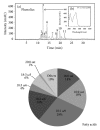Development of an Antioxidant Phytoextract of Lantana grisebachii with Lymphoprotective Activity against In Vitro Arsenic Toxicity
- PMID: 25002868
- PMCID: PMC4070537
- DOI: 10.1155/2014/416761
Development of an Antioxidant Phytoextract of Lantana grisebachii with Lymphoprotective Activity against In Vitro Arsenic Toxicity
Abstract
Phytochemicals have been presumed to possess prophylactic and curative properties in several pathologies, such as arsenic- (As-) induced immunosuppression. Our aim was to discover a lymphoprotective extract from Lantana grisebachii Stuck. (Verbenaceae) (LG). We assessed its bioactivity and chemical composition using cell-based assays. Fractions produced from a hexane extract acutely induced nitrite formation in T-activated cell cultures (P < 0.0001). Water extraction released a fraction lacking nitrite inducing activity in both lymphocyte types. Aqueous LG was found to be safe in proliferated and proliferating cells. The infusion-derived extract presented better antioxidant capacity in proportion to phenolic amount in lymphocytes (infusive LG-1i at 100 μ g/mL), which protected them against in vitro As-induced lymphotoxicity (P < 0.0001). This infusive LG phytoextract contained 10.23 ± 0.43 mg/g of phenolics, with 58.46% being flavonoids. Among the phenolics, the only predominant compound was 0.723 mg of chlorogenic acid per gram of dry plant, in addition to 10 unknown minor compounds. A fatty acid profile was assessed. It contained one-third of saturated fatty acids, one-third of ω 9, followed by ω 6 (~24%) and ω 3 (~4%), and scarce ω 7. Summing up, L. grisebachii was a source of bioactive and lymphoprotective compounds, which could counteract As-toxicity. This supports its phytomedical use and research in order to reduce As-related dysfunctions.
Figures





Similar articles
-
Effect of the Aqueous Extract of Lantana grisebachii Stuck Against Bioaccumulated Arsenic-Induced Oxidative and Lipid Dysfunction in Rat Splenocytes.J Diet Suppl. 2019;16(4):401-407. doi: 10.1080/19390211.2018.1470124. Epub 2018 Jun 29. J Diet Suppl. 2019. PMID: 29958031
-
Effects of oral phytoextract intake on phenolic concentration and redox homeostasis in murine encephalic regions.Nutr Neurosci. 2015 Oct;18(7):316-22. doi: 10.1179/1476830514Y.0000000130. Epub 2014 May 20. Nutr Neurosci. 2015. PMID: 24840738
-
Bioavailability of phenolic compounds and redox state of murine liver and kidney as sex-dependent responses to phytoextracts.Rev Fac Cien Med Univ Nac Cordoba. 2017 Dec 21;74(4):338-344. doi: 10.31053/1853.0605.v74.n4.15412. Rev Fac Cien Med Univ Nac Cordoba. 2017. PMID: 29902140
-
Total polyphenols and bioactivity of seeds and sprouts in several legumes.Curr Pharm Des. 2013;19(34):6112-24. doi: 10.2174/1381612811319340005. Curr Pharm Des. 2013. PMID: 23448441 Review.
-
Review on fresh and dried figs: Chemical analysis and occurrence of phytochemical compounds, antioxidant capacity and health effects.Food Res Int. 2019 May;119:244-267. doi: 10.1016/j.foodres.2019.01.055. Epub 2019 Jan 24. Food Res Int. 2019. PMID: 30884655 Review.
Cited by
-
Medicinal plants and natural products in amelioration of arsenic toxicity: a short review.Pharm Biol. 2017 Dec;55(1):349-354. doi: 10.1080/13880209.2016.1235207. Pharm Biol. 2017. PMID: 27931138 Free PMC article.
-
Antioxidant Effect of Coenzyme Q10 in the Prevention of Oxidative Stress in Arsenic-Treated CHO-K1 Cells and Possible Participation of Zinc as a Pro-Oxidant Agent.Nutrients. 2022 Aug 10;14(16):3265. doi: 10.3390/nu14163265. Nutrients. 2022. PMID: 36014770 Free PMC article.
-
Sustainable and efficient protocols for in vitro germination and antioxidants production from seeds of the endangered species Araucaria araucana.J Genet Eng Biotechnol. 2021 Dec 9;19(1):181. doi: 10.1186/s43141-021-00280-6. J Genet Eng Biotechnol. 2021. PMID: 34882279 Free PMC article.
References
-
- Goleniowski ME, Bongiovanni GA, Palacio L, Nuñez CO, Cantero JJ. Medicinal plants from the “Sierra de Comechingones”, Argentina. Journal of Ethnopharmacology. 2006;107(3):324–341. - PubMed
-
- Surh Y-J. Xenohormesis mechanisms underlying chemopreventive effects of some dietary phytochemicals. Annals of the New York Academy of Sciences. 2011;1229(1):1–6. - PubMed
-
- Bongiovanni GA, Soria EA, Eynard AR. Effects of the plant flavonoids silymarin and quercetin on arsenite-induced oxidative stress in CHO-K1 cells. Food and Chemical Toxicology. 2007;45(6):971–976. - PubMed
-
- Nasreddine L, Parent-Massin D. Food contamination by metals and pesticides in the European Union. Should we worry? Toxicology Letters. 2002;127(1–3):29–41. - PubMed
-
- Janeway CA, Jr., Travers P, Walport M, Shlomchik MJ. Immunobiology: The Immune System in Health and Disease. 5th edition. New York, NY, USA: Garland Science; 2001.
LinkOut - more resources
Full Text Sources
Other Literature Sources
Research Materials

